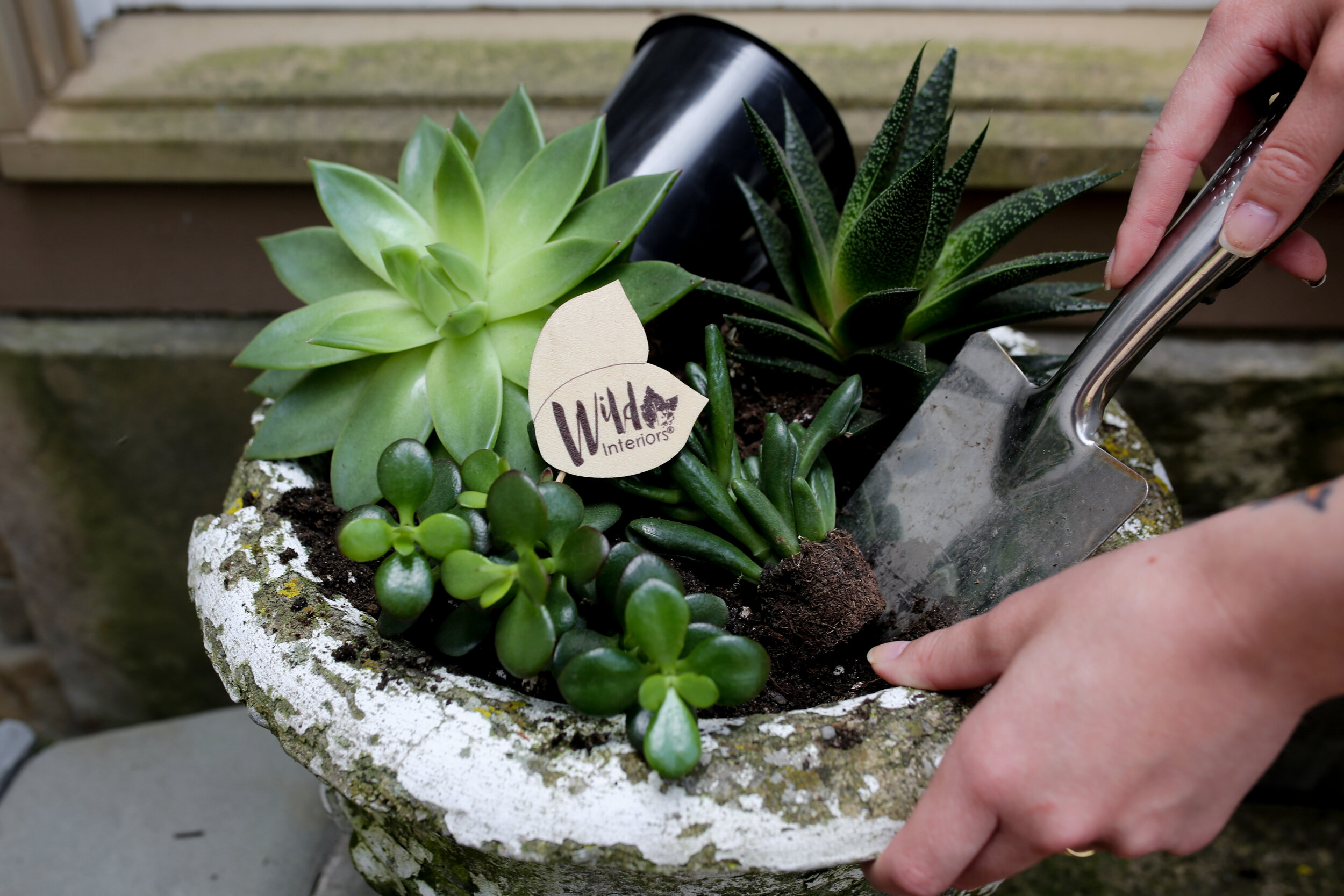Creating a DIY Planter with Houseplants
Image description: A concrete planter with multiple succulents being potted together. including echeveria, mini jade, hobbit jade (ogre’s ear), and gasteria.
Create Your Own DIY Planter
You’ve seen gorgeous outdoor flower planters on patios and porches overflowing with greenery, colorful flowers, and tall eye catching plants. Plants aren’t shy about making a statement around your home, but maybe you’re looking to spice things up with your indoor plant collection.
Houseplants can be planted together to create the same show stopping statement effect! If you aren’t already convinced that multiple houseplants in one container is a great idea, consider these reasons why you might actually want to give it a try.
Why You Might Want to Combine Houseplants Into a Planter
Creative DIY Project: It’s a fun and cheap DIY planter project, because you may already have all of the materials laying around your home!
Build Your Experience: While choosing the plants that work well together, you might learn more about each of your plant’s care needs. It’s important to group together plants that thrive in similar conditions. These are known as companion plants.
Time to Repot: Maybe it’s time for your plants to graduate to a new pot anyways. (Now you can finally use that large pot you picked up months ago, but you haven’t had anything large enough to put in it!)
Propagation: You already have the startings of new plant babies from your latest propagation project. Why not plant them in the same container for them to grow up together?
Something New: Maybe you just want to switch it up and keep things fresh. Make use of your existing plant collection to create something new and exciting.
Benefits of Indoor Plants
Indoor plants give us more than we probably deserve. There are many benefits to having foliage within your home. Foliage plants improve the air quality, reduce stress, promote a good night's rest, and even make a great pet-alternative. Not to mention, they are pretty low maintenance.
Succulents also provide us with many advantages. They, too, improve the air quality, help enhance mental health, and generally require little attention. Check out our blog to see more about succulent benefits and care tips.
Tips from an Experienced Grower
We asked one of our greenhouse growers, Wayne, to share tips on how to properly plant houseplants together. Wayne says, when combining different plants, “consider the different habits and root systems of each plant.” If you plant a vigorous variety, such as a pothos, be prepared to prune it back to keep it from stealing the show from your other plants in the mix. You can propagate your cuttings to keep the growth going!
It is also important to combine plants that would work well together, also known as companion plants. Companion plants are those that have the same light, nutrition, and watering needs.
Wayne says, “You should not plant tropical plants with plants that come from other habitats.” In other words, you wouldn’t want to plant a succulent (who enjoys lots of light and desert like conditions) with a fern (who likes consistently damp soil and thrives in low light conditions).
How to Create a DIY Planter
To get the most pizzazz out of your houseplant planter, use plants that “thrill, fill, and spill.” Using this technique will allow for a variety of colors and textures to create that “wow” factor.
Thrill: Use one plant that is tall and eye-catching. This plant should be centered near the back of the pot. Think of plants such as the Snake Plant, Aloe, or Yucca Cane.
Fill: Use plants that do not grow taller than your “thrill” plant. They ideally should fill out the pot and create different textures. These plants should be placed in front of and around your tall, eye catching plant. Some filler plants include: Aglaonema Red Valentine, Nerve Plant, Spider Plant, or a Baby Rubber Plant.
Spill: Use cascading plants to create movement out of the container. These plants should be planted near the outer edges of the pot. Some trailing plants include: Pothos, Zebrina, and Ivy.
When transplanting your plants from their original pots, be extra careful with the roots to prevent any root damage. For best potting practice add soil to the bottom of your pot, loosely place your plants inside, and fill the remaining space with soil mix. If you’re wondering what soil type is the best for your plants, check out our guide on how to choose the best potting mix.
Choosing the best plant combinations is key to keeping your plants happy and healthy in their new shared home. As mentioned before, succulents and moisture loving plants aren’t exactly the perfect couple. Try pairing succulents with each other as shown in our step by step guide on how to make a succulent terrarium. If you wish to bottom water your succulent planter, be sure to plant your arrangement in a plastic grower pot that fits your desired decorative pot.
When placing foliage plants together, keep in mind their needs for light, water, and humidity. All of these care needs should be very similar if they are put in the same container.
Houseplant Planter Combos To Try
Calathea Wavestar, Fittonia, and Tradescantia Zebrina
Peperomia Baby Rubber Plant and Pothos
Blue Star Fern and Rabbit’s Foot Fern
Aloe Mitriformis, Ripple Jade, and String of Bananas
Finally, remember to keep an eye on your plants and if they seem to not enjoy their new neighborhood, it’s okay to learn from the experience and re-pot them on their own. Try piecing together your plants to see what kind of masterpiece you can create. Happy planting!

